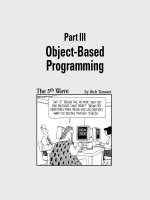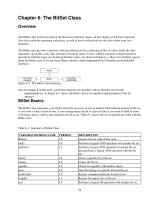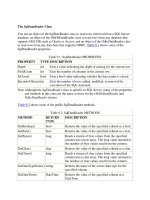The BitSet Class
Bạn đang xem bản rút gọn của tài liệu. Xem và tải ngay bản đầy đủ của tài liệu tại đây (17.93 KB, 6 trang )
Chapter 6: The BitSet Class
Overview
The BitSet class is the least used of the historical collection classes. In this chapter, you'll learn where the
class fits in with the remaining collections, as well as how to effectively use the class within your Java
programs.
The BitSet class provides a memory−efficient abstraction for a collection of bits. In other words, the class
represents a growable, array−like structure of boolean values. In fact, a BitSet can grow without bounds to
provide an infinitely large set of indexed boolean values. As shown in Figure 6−1, there isn't anything special
about the BitSet class. It is your basic Object subclass, which implements the Cloneable and Serializable
interfaces.
Figure 6−1: The BitSet class hierarchy.
Note In Chapter 8 of this book, you'll learn about the Set interface with its HashSet and TreeSet
implementations. As Figure 6−1 shows, the BitSet class is not another implementation of the Set
interface.
BitSet Basics
The BitSet class represents a set of bits where the set grows in size as needed. Each indexed element of the set
is a bit with a value of zero or one. A zero setting means the bit is clear (or false if you want to think in terms
of boolean values), while a one represents the bit as set. Table 6−1 shows the set of methods provided with the
BitSet class.
Table 6−1: Summary of BitSet Class
VARIABLE/METHOD NAME VERSION DESCRIPTION
BitSet() 1.0 Creates a bit set with all bits clear.
and() 1.0 Performs a logical AND operation with another bit set.
andNot() 1.2 Performs a logical NOT operation of another bit set,
then performs a logical AND operation with this bit
set.
clear() 1.0 Clears a specific bit of the set.
clone() 1.0 Copies the bit set.
equals() 1.0 Checks for equality with another object.
get() 1.0 Gets the setting of a specific bit from the set.
hashCode() 1.0 Returns computed hashcode for the bit set.
length() 1.2 Returns the logical size of the set.
or() 1.0 Performs a logical OR operation with another bit set.
73
set() 1.0 Sets a specific bit of the set.
size() 1.0 Returns the internal space used to represent the bit set.
toString() 1.0 Converts the bit set contents into a string.
xor() 1.0 Performs a logical XOR operation with another bit set.
Creating Bit Sets
There are two ways to create a BitSet. You can either specify an initial bit set size, or not:
public BitSet()
public BitSet(int nbits)
If you don't specify a size, an internal structure will be created to store sixty−four different bit settings. If you
do specify a size, the structure size will be rounded up to the nearest multiple of sixty−four.
Note A NegativeArraySizeException will be thrown if the initial size is negative.
When a bit set is created, all bits in the set are clear, or set to zero. After creating the set, if setting or clearing
bits happens at a higher position than the current set size, the set size will grow.
Printing Bit Sets
The BitSet class overrides the toString() method inherited from Object:
public String toString()
The string generated by calling the toString() method is a comma−delimited list of set bit positions, which is
set and is surrounded by curly braces ({ }). For example, if the bits at position 0, 36, and 42 were set, calling
toString() would generate the following string:
{0, 36, 42}
When a BitSet is first created, the returned string is the empty set:
{}
Bit Set Operations
Once you've created the bit set, you can work with either individual bits or the set as a whole.
Manipulating Individual Bits
When working with individual bits, you usually need to change or get their setting. There are two methods for
changing the setting: set() and clear(). There is one for getting: get(). Each of the methods accepts a position
argument to specify the zero−based index of the bit to change.
public void set(int position)
public void clear(int position)
Creating Bit Sets
74
public boolean get(int position)
If the position specified in the set() method is beyond the size of the bit set, the set grows in increments of
sixty−four. Calling clear() with a position beyond the set size does nothing. If the position specified in a call
to get() is beyond the set size, false is returned without growing the set. For valid position sizes, true is
returned if the position is set (1), or false if clear (0). For all three methods, if the position is negative, an
IndexOutOfBoundsException will be thrown.
Manipulating Sets of Bits
There are four methods for performing set−wide operations on the bit set. Each performs a logical operation
of the corresponding bits of the two sets:
public void and(BitSet set)
public void or(BitSet set)
public void xor(BitSet set)
public void andNot(BitSet set)
For the AND operation, each bit in the current bit set will be set (1) if it is already set and if the corresponding
bit in the passed−in set is also set. This roughly equates to the following:
this[index] &= set[index]
For the OR operation, the bit in the current bit set will be set (1) if it is already set or if the corresponding bit
in the passed in set is set. This can be expressed as:
this[index] |= set[index]
For the XOR operation, the bit in the current bit set will be set (1) if it is already set or if the corresponding bit
in the passed−in set is set, but not if both bits are set. Or, looked at in another way, the bit is set if it differs
from the corresponding bit in the passed−in set and is cleared if it is the same. This can be expressed as:
this[index] ^= set[index]
For the NAND (not add) operation, the bit in the current bit set will be cleared (0) if the corresponding bit is
already set in the passed in set. This roughly equates to the following:
this[index] &= ~set[index]
To demonstrate these four operations, Table 6−2 shows what happens when you perform the different
operations with an original bit set of {1, 2, 3, 4, 5} and a passed in set of {1, 3, 5, 7}.
Table 6−2: Set Manipulation
OPERATION RESULTS
and() {1, 3, 5}
or() {1, 2, 3, 4, 5, 7}
xor() {2, 4, 7}
andNot() {2, 4}
Manipulating Sets of Bits
75
If there is a size difference between the two sets, the size of the resulting set depends on the method called.
Under no condition will the contents of the passed−in set change in size or content as a result of the method
call.
and(): If the size of the current set is smaller than the passed−in set, the extra bits are ignored. If the
size of the current set is larger than the passed−in set, the extra bits are cleared/set to zero.
•
or() / xor(): If the size of the current set is smaller than the passed−in set, the size of the current set is
increased to match the size of the passed−in set. All new bits are cleared/set to zero before performing
the operation.
•
andNot(): If the sizes are different in either direction, the extra bits are ignored/unchanged.•
Note A NullPointerException will be thrown if you pass in a null set to any of these methods.
Determining Set Size
Think of a BitSet as a dynamically growing array composed of bits, similar to a vector. This dynamically
growing structure has two values describing its internal dimensions: a size and a length.
public int size()
public int length()
The size() method will return the number of bits reserved in the set and grows in increments of sixty−four.
Think of this value like the capacity when working with a vector. On the other hand, the length() of a bit set is
the last position that is set. Since positions are indexed starting from zero, this equates to the index of the
highest set bit plus one.
Note One odd behavior of a bit set's length is that if you clear the highest set bit, the set's length can drop
more than one depending upon where the next highest set bit is located.
Cloning Bit Sets
The BitSet class implements the Cloneable interface, providing you with a clone() method.
public Object clone()
When you clone() a BitSet, you create another set with the same size and the same bit positions set.
Checking Bit Sets for Equality
The BitSet class overrides the equals() method from Object to define the equality of bit sets.
public boolean equals(Object object)
Two bit sets are defined as equal if both bit sets have the same set or clear state at every position. In other
words, this[index]=object[index] must be true for each index in both sets. When one set is shorter than the
other, the remaining elements would need to be clear in the longer set for both sets to be equal.
Hashing Bit Sets
Besides overriding the equals() method of Object, the BitSet class also overrides the hashCode() method. The
generated hash code is only based on the position of the set bits:
Determining Set Size
76
public int hashCode()
Using BitSet: an Example
To demonstrate the usage of the BitSet class, Listing 6−1 creates a set of candy where the bit is set if the name
has an even number of characters. It then prints out all the odd types of candy and shows the set size and
length. Finally, it demonstrates the andNot() method by combining the first set with a second set where the
first four elements are all set.
Listing 6−1: Demonstrating the use of BitSet.
import java.util.BitSet;
public class BitOHoney {
public static void main (String args[]) {
String names[] = {
"Hershey's Kisses", "Nestle's Crunch",
"Snickers", "3 Musketeers",
"Milky Way", "Twix", "Mr. Goodbar",
"Crunchie", "Godiva", "Charleston Chew",
"Cadbury's", "Lindt", "Aero", "Hebert",
"Toblerone", "Smarties", "LifeSavers",
"Riesen", "Goobers", "Raisinettes", "Nerds",
"Tootsie Roll", "Sweet Tarts", "Cotton Candy"};
BitSet bits = new BitSet();
for (int i=0, n=names.length; i<n; i++) {
if ((names[i].length() % 2) == 0) {
bits.set(i);
}
}
System.out.println(bits);
System.out.println("Size : " + bits.size());
System.out.println("Length: " + bits.length());
for (int i=0, n=names.length; i<n; i++) {
if (!bits.get(i)) {
System.out.println(names[i] + " is odd");
}
}
BitSet bites = new BitSet();
bites.set(0);
bites.set(1);
bites.set(2);
bites.set(3);
bites.andNot(bits);
System.out.println(bites);
}
}
When run, this program produces this output:
{0, 2, 3, 5, 7, 8, 12, 13, 15, 16, 17, 21, 23}
Size : 64
Length: 24
Nestle's Crunch is odd
Using BitSet: an Example
77









